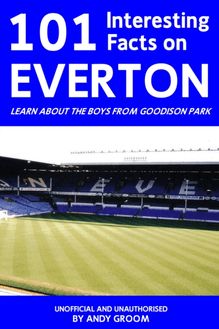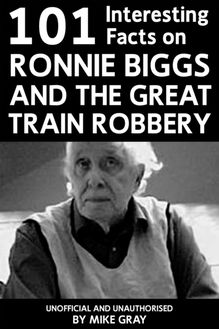101 Interesting Facts on Everton , livre ebook
58
pages
English
Ebooks
2014
Vous pourrez modifier la taille du texte de cet ouvrage
Obtenez un accès à la bibliothèque pour le consulter en ligne En savoir plus
Découvre YouScribe en t'inscrivant gratuitement
Découvre YouScribe en t'inscrivant gratuitement
58
pages
English
Ebooks
2014
Vous pourrez modifier la taille du texte de cet ouvrage
Obtenez un accès à la bibliothèque pour le consulter en ligne En savoir plus
Publié par
Date de parution
03 avril 2014
Nombre de lectures
1
EAN13
9781910295205
Langue
English
Publié par
Date de parution
03 avril 2014
Nombre de lectures
1
EAN13
9781910295205
Langue
English
Title Page
101 INTERESTING FACTS ON EVERTON
Learn About The Boys From Goodison Park
By
Andy Groom
Publisher Information
Apex Publishing Ltd
PO Box 7086, Clacton on Sea,
Essex, CO15 5WN, England
www.apexpublishing.co.uk
Please email any queries to Chris Cowlin:
mail@apexpublishing.co.uk
Digital Edition converted and published by
Andrews UK Limited 2014
www.andrewsuk.com
Copyright © 2014 Andy Groom
The author has asserted his moral rights
All rights reserved. This book is sold subject to the condition, that no part of this book is to be reproduced, in any shape or form. Or by way of trade, stored in a retrieval system or transmitted in any form or by any means, electronic, mechanical, photocopying, recording, be lent, re-sold, hired out or otherwise circulated in any form of binding or cover other than that in which it is published and without a similar condition, including this condition being imposed on the subsequent purchaser, without prior permission of the copyright holder.
About the Author
Andy Groom was born in 1978. Encouraged by his family, Andy played football from an early age and accompanied his mum and dad to watch Everton play. As a youngster, Andy enjoyed drawing and would spend his school days doodling the Everton badge and sketching players.
As a lifelong Everton fan, Andy has supported the team through good times and bad, making the journey to Goodison and beyond over the years, to witness the team’s triumphs and disappointments.
Andy is also the author of ‘England’s World Cup Story: From Winterbottom’s 1950 to Capello’s 2010’ and ‘The Illustrated Everton History’, both published by Apex Publishing Ltd.
The Facts Prince Rupert’s Tower. Everton’s Tower was named after Prince Rupert. On a hill called Everton Brow in Netherfield Road, Prince Rupert’s Tower is an old Lock and in 1787 it was opened for usage, to hold criminals and drunk’s before the magistrates in the morning. Criminals and so on, the day before the magistrate, they were ordered to do community service perhaps, unblocking drains or clearing rubbish. Whose army camped in the area during the English Civil War of the 1640’s, commander of King Charles I stayed in a cottage on top of the hill during the build-up to an attack on Liverpool Castle. The Tower Grade II-listed building has been a significant feature in Everton’s history. St Domingo then Everton. Everton was founded as St Domingo’s in 1878. In May 1870, the St Domingo Methodist Church Sunday School was opened with organist George Mahon and Rev. BS Chambers was appointed minister. In the south-east corner of Stanley Park, the St Domingo Football Club played its first match with the players who carried the goal posts from the Park Lodge on Mill Lane. A meeting at the Queens Head Hotel in Village Street, six members participated in November 1879 the district Everton was named. The First Everton game. On 20 th December 1879, the first official ever Everton Football Club game took place at Stanley Park against St Peter’s. Everton won 6-0 wearing blue and white stripes. Hotel owner John Houlding’s house was near to the Park that watched the large crowds. There are no records of the line up. Everton’s Nickname’s... Everton had and have nicknames over the years. In the 19 th Centaury, Everton trained hard, sometimes at night, soon adopting an early nickname, ‘The Moonlight Dribblers’. In 1881, Everton wore their same colour jerseys from their previous teams during the match. The confusion led to Everton opting for a kit of the same colour. To save as little money as they had, Everton dyed the kit to the unfamiliar colours of black shirts with a scarlet slash. The nickname for the club became the ‘Black Watch’ named after the Highland Regiment. A new colour became Blue, the ‘Blues’ famously claimed one of the most renowned nicknames in the game also the ‘Toffees’ or ‘The Toffeemen’. The two most popular Toffee nicknames first originating from a local sweet shop called Mother Noblett’s Toffee Shop which advertised and sold sweets, including the Everton Mint, on match days. The other deemed, Molly Bushel’s ‘Toffey Shop’ that also a shop that sold sweets and toffees. Everton’s 1960’s and 70’s manager Harry Catterick had built a side of exceptional experience and a mixture of youth, an Everton side known as ‘The School of Science’. In 1961, Chairman Sir John Moores CBE was believed to of sacked manager John James “Johnny” Carey in the back of a taxi to make way for a golden handshake for new appointment Catterick in 1961. Catterick used to come out training with the players at Bellefield - and players were convinced that he had his suit on under his tracksuit, the Everton troupes had to be in by 10am and at 9.45am there was a blue pen waiting, by 10am there was a red pen to sign for the players who would be signed. Catterick was renowned for his ‘different’ approach to scouting and signing players, as he was known to disguise himself when watching the players under his consideration. Catterick was good with working with players even in five-a-side matches at training, quick and sharp that was recalled the ‘The School of Science’. Catterick had been an Everton player, playing as centre forward in 1946-1951 scoring 24 goals in 59 matches. Harry Catterick inspired Everton to two top Division Championships (1992-63, 1969-70) and one FA Cup (1965-66) along with two Charity Shields (1963, 1970). David William Moyes adopted the phrase ‘The peoples Club’ for the most recent nickname. On March 14, 2002 at a 7.15pm, a press conference announced that Moyes was the new Everton manager after agreeing compensation with his former club Preston North End. Moyes drove to Preston from London and back in a 550-mile round trip, Everton Chairman Bill Kenwright CBE contacted Moyes and invited him to his home in London to discuss the available position at Everton. Moyes’s tactical awareness and motivation was second to none, and his signings have proved to be successful. It was clear to see the Scotsman’s philosophy with signing young, building for the future for Everton. Moyes was a defender by trade in his playing days. For Everton, Moyes host’s three ‘LMA Manager of the Year’ (2002-03, 2004-05, 2008-09) and won the FA Premier League Manager of the Month Award ten times, in 2005 Everton qualified for the Champions League for the first time and reached the FA Cup Final in 2009 under Moyes. In November 2012, Moyes celebrated his 400 th Premier League game win 2-1 against Sunderland. Steve Rotheram MP in Parliament also raised his service to Everton. David Moyes’s adopted turn of phrase ‘The Peoples Club’ and Moyes received the nickname ‘Dithering Dave’ from many fans. The Twelve Founders. Everton became one of the twelve founders of the Football League in 1888. On 2 nd March 1888, director of Aston Villa’s William McGregor wrote to the committee of Aston Villa and Blackburn Rovers, Bolton Wanderers, Preston North End, Stoke F.C and West Bromwich Albion and a League competition was created. On 23 rd March, a meeting was held at Anderton’s Hotel in London, then on the Football League was formally fashioned and named in Manchester at a further meeting on 17 th April at the Royal Hotel. The Royal Hotel is now marked with a red plaque on the Royal Buildings in Market Street, as the Royal Hotel is long gone. On 8 th September 1888, twelve member clubs from the North of England and the Midlands, Everton are one of the twelve founders Accrington, Aston Villa, Blackburn Rovers, Bolton Wanderers, Preston North End, Stoke F.C, Notts County, Wolverhampton Wanderers, Burnley, Derby County and West Bromwich Albion. A point’s system was not agreed upon until after the season had started each club played the other twice, once at home and once away, and two points were awarded for a win and one for a draw. Everton’s First ever League Match. On 8 th September 1888, Everton played their first ever League match and won 2-1 against Accrington Stanley. The game kicked off about 4.25 pm because the visitors arrived 20 minutes late. At Anfield 12,000 attended to watch George S Fleming score 2 goals, one in the hour facing the sun and the second in the end of the game. Accrington headed the bar in the last seconds unable to equalise that game that hosted the 125 years of the Football League on 8 th September 2013. George Fleming was Everton’s first League goal scorer with making 5 appearances and scoring 2 goals with an 1887-1888 seasons Everton career. 125 years ago (2014), Everton pounded Accrington Stanley with grit and method 4-1 on Wednesday 17 th July 2013 at Store First Stadium formerly known as the Crown Ground. Roberto Martínez Montoliú won his first victory as Everton manager. In the 11 th minute the midfielder Darron Thomas Daniel Gibson put in a low drive. The fine Kevin Antonio Joel Gislain Mirallas y Castillo guided a super pass through to Victor Chinedu Anichebe who headed in a 16 th minute goal. Just before half time, Kevin Mirallas netted 1 goal then Leon Osman finished the game in the 63 rd minute. In the 2013 game, 1,600 Everton travelling supporters was a similar match up from 1888. Everton’s Record Victory is 11-2. On 18 th January 1890, Everton won 11-2 holding Everton’s record victory with left back Daniel “Dan” Doyle, David Kirkwood and hat-tricks hero’s Fred Geary, Alexander “Alec” Brady and Alfred “Alf” Weatherell Milward who finished off Derby County in the FA Cup 5 th Round. Everton’s 11-2 victory hosted players in this era such as, left back Scottish Doyle made 45 appearances and scored just 1 goal and even captained Everton’s first Championship winning side. Doyle lived in England in a boarding house with several Evertonians and Dan Doyle returned to Glasgow Celtic in 1890 and Everton tried to tempt him


